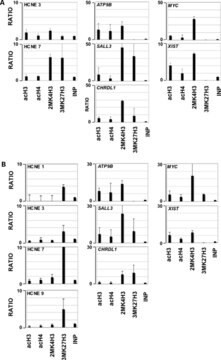06-583
Przeciwciało anty-Lck
Upstate®, from rabbit
Zaloguj sięWyświetlanie cen organizacyjnych i kontraktowych
About This Item
Kod UNSPSC:
12352203
eCl@ss:
32160702
NACRES:
NA.41
Polecane produkty
pochodzenie biologiczne
rabbit
Poziom jakości
forma przeciwciała
purified antibody
rodzaj przeciwciała
primary antibodies
klon
polyclonal
reaktywność gatunkowa
human
opakowanie
antibody small pack of 25 μg
producent / nazwa handlowa
Upstate®
metody
immunoprecipitation (IP): suitable
western blot: suitable
izotyp
IgG
numer dostępu NCBI
numer dostępu UniProt
Warunki transportu
dry ice
docelowa modyfikacja potranslacyjna
unmodified
informacje o genach
human ... LCK(3932)
Opis ogólny
Kinaza białkowo-tyrozynowa Lck (UniProt: P06239; znana również jako EC:2.7.10.2, Leukocyte C-terminal Src kinase, LSK, Lymphocyte cell-specific protein-tyrosine kinase, Protein YT16, Proto-oncogene Lck, T cell-specific protein-tyrosine kinase, p56-LCK) jest kodowana przez gen LCK (Gene ID: 3932) u człowieka. Lck jest niereceptorową kinazą tyrozynową, która ulega specyficznej ekspresji w komórkach limfoidalnych. Jego domena kinazy białkowej jest zlokalizowana w aminokwasach 245-498. Odgrywa ona istotną rolę w selekcji i dojrzewaniu rozwijających się komórek T w grasicy, a także odgrywa rolę w funkcjonowaniu dojrzałych komórek T. Stwierdzono, że konstytutywnie wiąże się z cytoplazmatycznym regionem receptorów CD4 i CD8. Odgrywa również rolę w sygnalizacji związanej z receptorem antygenowym limfocytów T (TCR). Asocjacja TCR z kompleksem MHC związanym z antygenem peptydowym ułatwia interakcję CD4 i CD8 odpowiednio z cząsteczkami MHC klasy II i klasy I. Powoduje to rekrutację Lck w pobliże kompleksu TCR/CD3, gdzie Lck może fosforylować reszty tyrozynowe w obrębie motywów aktywacji opartych na tyrozynie immunoreceptora (ITAM) cytoplazmatycznych ogonów łańcuchów TCR i podjednostek CD3, co inicjuje sygnalizację TCR/CD3. Po stymulacji TCR rekrutuje kinazę tyrozynową ZAP70, która ulega fosforylacji i aktywacji przez Lck. Następnie rekrutowana jest duża liczba cząsteczek sygnałowych, co ostatecznie prowadzi do produkcji limfokin. Autofosforylacja Lck na tyrozynie 394 zwiększa jego aktywność enzymatyczną, podczas gdy fosforylacja na tyrozynie 505 przez C-końcową kinazę Src (CSK) powoduje zmniejszenie jego aktywności. (Ref.: Rossy, J., et al. (2012). Front. Immunol. 3; 167; Bergman, M., et al. (1992). EMBO J. 11(8); 2919-2924).
Specyficzność
To królicze przeciwciało poliklonalne wykrywa kinazę tyrozynowo-białkową Lck. Celuje w epitop w regionie N-końcowym.
Immunogen
Rekombinowany fragment znakowany GST odpowiadający pierwszym 58 aminokwasom z N-końcowego regionu ludzkiej kinazy tyrozynowo-białkowej Lck.
Zastosowanie
Testy kontroli jakości
Oceniane metodą Western Blotting w lizacie komórek Jurkat. Analiza Western Blotting: Rozcieńczenie 1:1000 tego przeciwciała wykryło Lck w lizacie komórek Jurkat. Testowane aplikacje
Analiza immunoprecypitacji: Reprezentatywna partia immunoprecypitowała Lck w lizacie komórek Jurkat.Uwaga: Rzeczywiste optymalne rozcieńczenia robocze muszą być określone przez użytkownika końcowego jako próbki, a warunki eksperymentalne mogą się różnić w zależności od użytkownika końcowego.
Oceniane metodą Western Blotting w lizacie komórek Jurkat. Analiza Western Blotting: Rozcieńczenie 1:1000 tego przeciwciała wykryło Lck w lizacie komórek Jurkat. Testowane aplikacje
Analiza immunoprecypitacji: Reprezentatywna partia immunoprecypitowała Lck w lizacie komórek Jurkat.Uwaga: Rzeczywiste optymalne rozcieńczenia robocze muszą być określone przez użytkownika końcowego jako próbki, a warunki eksperymentalne mogą się różnić w zależności od użytkownika końcowego.
Jakość
routinely evaluated by immunoblot on RIPA lysates from Jurkat cells
Opis wartości docelowych
Zaobserwowano ~56 kDa; obliczono 58,0 kDa. W niektórych lizatach można zaobserwować niescharakteryzowane pasma.
Powiązanie
Zastępuje: 04-372
Postać fizyczna
Chromatografia białka A
Format: Oczyszczony
Oczyszczone królicze przeciwciało poliklonalne w buforze zawierającym 0,1 M Tris-Glicyna (pH 7,4), 150 mM NaCl z 0,05% azydkiem sodu.
Przechowywanie i stabilność
Przechowywać w temperaturze od -10°C do -25°C. Zalecenia dotyczące postępowania: Po otrzymaniu i przed zdjęciem nasadki odwirować fiolkę i delikatnie wymieszać roztwór. Rozdzielić do probówek mikrowirówkowych i przechowywać w temperaturze -20°C. Unikać powtarzających się cykli zamrażania/rozmrażania, które mogą uszkodzić IgG i wpłynąć na działanie produktu.
Komentarz do analizy
Kontrola
Pozytywna kontrola antygenu: Katalog #12-303, Lizat komórek Jurkat.
Pozytywna kontrola antygenu: Katalog #12-303, Lizat komórek Jurkat.
Informacje prawne
UPSTATE is a registered trademark of Merck KGaA, Darmstadt, Germany
Oświadczenie o zrzeczeniu się odpowiedzialności
O ile nie określono inaczej w naszym katalogu lub innej dokumentacji firmy dołączonej do produktu(-ów), nasze produkty są przeznaczone wyłącznie do użytku badawczego i nie mogą być wykorzystywane do żadnych innych celów, w tym między innymi do nieautoryzowanych zastosowań komercyjnych, zastosowań diagnostycznych in vitro, zastosowań terapeutycznych ex vivo lub in vivo lub jakiegokolwiek rodzaju konsumpcji lub zastosowania u ludzi lub zwierząt.
Ta strona może zawierać tekst przetłumaczony maszynowo.
Nie możesz znaleźć właściwego produktu?
Wypróbuj nasz Narzędzie selektora produktów.
Certyfikaty analizy (CoA)
Poszukaj Certyfikaty analizy (CoA), wpisując numer partii/serii produktów. Numery serii i partii można znaleźć na etykiecie produktu po słowach „seria” lub „partia”.
Masz już ten produkt?
Dokumenty związane z niedawno zakupionymi produktami zostały zamieszczone w Bibliotece dokumentów.
J D Marth et al.
The EMBO journal, 6(9), 2727-2734 (1987-09-01)
The lymphocyte-specific protein tyrosine kinase pp56lck, encoded by a member of the src gene family, is implicated in the control of T-cell growth and differentiation. Purified resting human T lymphocytes contain appreciable levels of lck mRNA and of pp56lck. Upon
Revaluation of the role of cholesterol in stabilizing rafts implicated in T cell receptor signaling.
Alexandre K Rouquette-Jazdanian,Claudette Pelassy,Jean-Philippe Breittmayer,Claude Aussel
Cellular Signalling null
H Lin et al.
The Journal of biological chemistry, 273(31), 19914-19921 (1998-07-25)
Human CD2 is a 50-55-kDa cell surface receptor specifically expressed on the surface of T lymphocytes and NK cells. Stimulation of human peripheral blood T cells with mitogenic pairs of anti-CD2 monoclonal antibodies (mAbs) is sufficient to induce interleukin-2 production
A H Zea et al.
Infection and immunity, 66(2), 499-504 (1998-02-07)
Advanced stages of mycobacterial diseases such as leprosy and tuberculosis are characterized by a loss of T-cell function. The basis of this T-cell dysfunction is not well understood. The present report demonstrates major alterations in the expression of signal transduction
S Shin et al.
Oncogene, 8(1), 141-149 (1993-01-01)
We have analysed DNA and RNA from 36 T-cell lymphomas induced in Fischer rats by Moloney murine leukemia virus for alterations affecting the structure or expression of the lck gene. At least five primary tumors (14%) have a proviral insertion
Nasz zespół naukowców ma doświadczenie we wszystkich obszarach badań, w tym w naukach przyrodniczych, materiałoznawstwie, syntezie chemicznej, chromatografii, analityce i wielu innych dziedzinach.
Skontaktuj się z zespołem ds. pomocy technicznej








